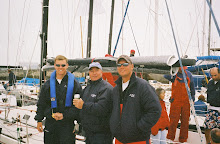First off, there was a large crack on the port combing, that was repaired once but has seemed to open up again. The first attempt at fixing this problem involved drilling and embedding 1/4" x 6" long bronze machine bolts from the bottom, and some epoxy. That worked for a little while, but as the years went on, the crack grew in length, and the combing became less stiff.
 Next was the issue with the king plank on the foredeck. I have pictures of the boat when she was brand new, and the crack was there from the beginning. It has been filled with epoxy, varnished over and starts to crack further forward. As you can see from the picture below; I am running out of boat.
Next was the issue with the king plank on the foredeck. I have pictures of the boat when she was brand new, and the crack was there from the beginning. It has been filled with epoxy, varnished over and starts to crack further forward. As you can see from the picture below; I am running out of boat.  Then there was the knot meter. Great in concept, but horrible in use. Don't get me wrong, if they work they can be a asset. However this one did not, and has become more of an eye sore then anything else. The problem with this is that you leave an unsightly hole in the bulkhead once the knot meter has been removed. I'll have to think about that one, but we still have lots to do and plenty of time to resolve that issue.
Then there was the knot meter. Great in concept, but horrible in use. Don't get me wrong, if they work they can be a asset. However this one did not, and has become more of an eye sore then anything else. The problem with this is that you leave an unsightly hole in the bulkhead once the knot meter has been removed. I'll have to think about that one, but we still have lots to do and plenty of time to resolve that issue.
While thinking the knot meter issue through my mind, I noticed another unsightly hole in the boat. Although useful if utilized (Not by many boats in S.F.) The stock position of the backstay control line. Hey, if having your crew jump off the rail, and adjust it while you kick them in the face is your secret to boat speed, so be it. It isn't my cup of tea. Most boats that are raced here regularly have run the backstay threw the deck hiding the rats nest of purchase, leading the controls just forward of the skipper, on both sides for easier adjustment from the rail. So, add that one to my list.
 Like I said, the "To Do" list has changed..... We have our ideas on fixes, but the 1,000 chicken shit little details keep popping up. Other problems that need attention include:
Like I said, the "To Do" list has changed..... We have our ideas on fixes, but the 1,000 chicken shit little details keep popping up. Other problems that need attention include:
- The teak laminate on the front of the cockpit seat is peeling on the starboard side and needs to be repaired or replaced.
- The cabin top is too weathered to just patch and blend and really should be re-painted.
- The waterline on the rudder is painted the wrong color blue.
- Nameplates were installed over the divots left by the jib lead blocks (When we sheeted to the deck). Bleach and repair the cabin sides where this has taken place.
- I know that there are a bunch more, I just need to find them..............
We have a lot to think about repairing, and figuring out a slick way to accomplish it.








